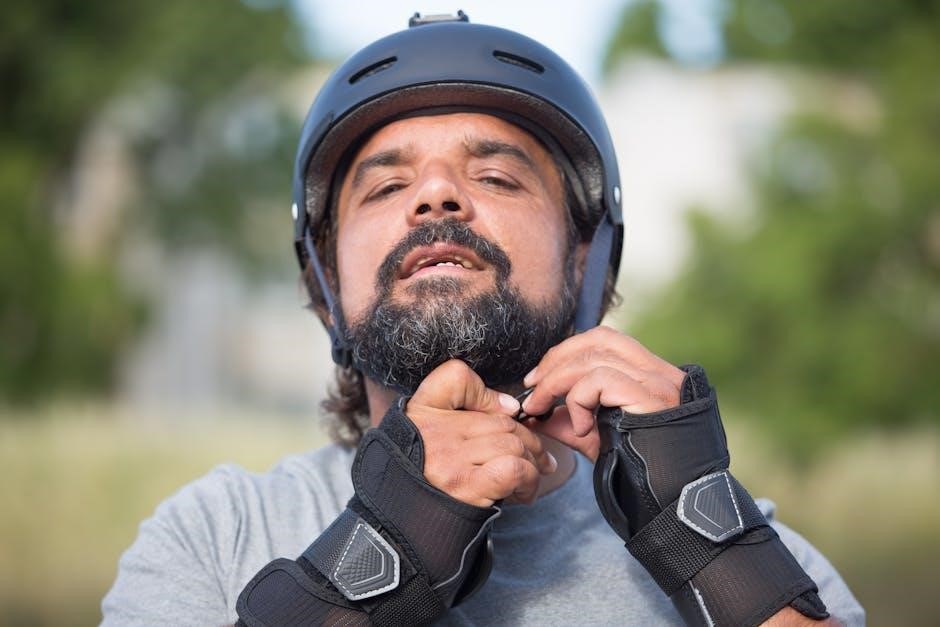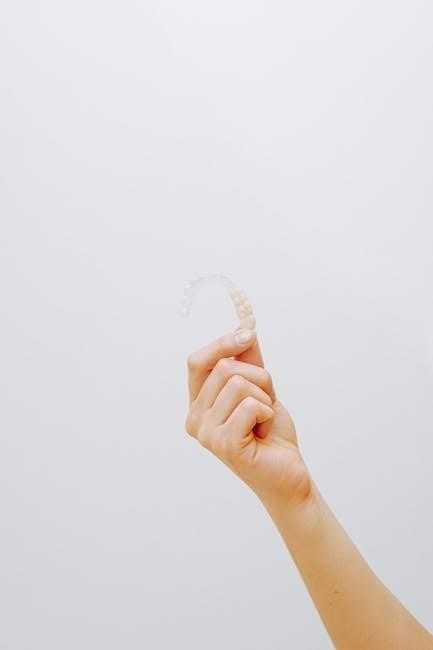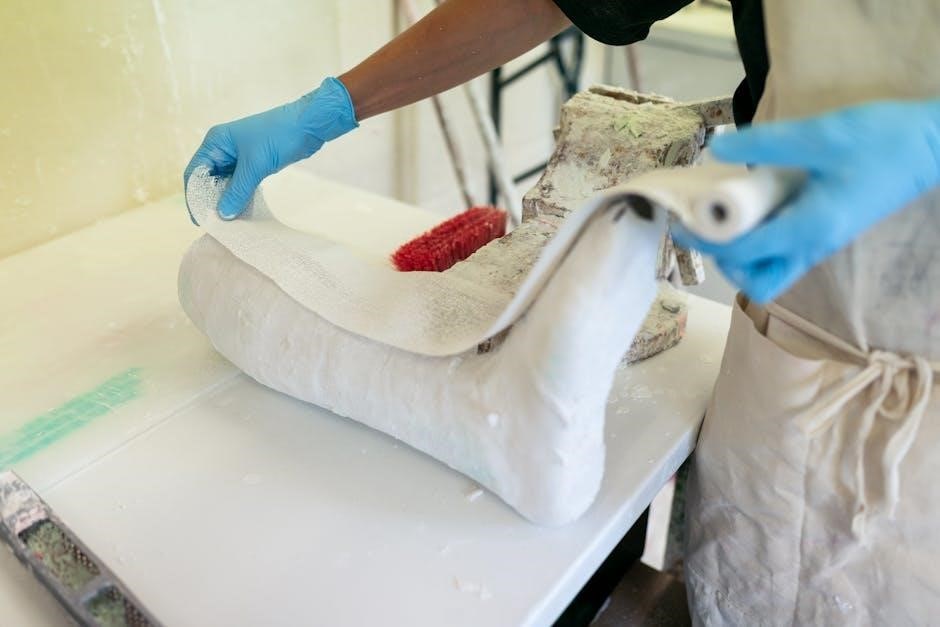What is a TLSO Brace?
Definition and Purpose
A TLSO (Thoracic-Lumbar-Sacral Orthosis) brace is a custom-molded plastic device designed to protect, stabilize, and limit motion in the thoracic, lumbar, and sacral regions of the spine. It is typically used after spinal surgery or injury to provide support and promote proper healing by restricting movement.
Overview of TLSO Brace Instructions
A TLSO brace is a custom-molded plastic device designed to protect, stabilize, and limit motion in the thoracic, lumbar, and sacral regions of the spine. Proper application involves lying flat on your back, ensuring the brace is snug and securely fastened with straps. Regular wear schedules and careful maintenance are essential for optimal support and comfort. Instructions emphasize avoiding activities that involve twisting or bending, as well as proper hygiene practices, such as showering with the brace on and drying it thoroughly afterward. Adhering to these guidelines ensures the brace functions effectively, promoting spinal healing and stability.
Importance of Proper Usage and Care
Proper usage and care of a TLSO brace are crucial for ensuring its effectiveness and comfort. Improper use can lead to discomfort, skin irritation, or even complications in the healing process. The brace is designed to limit spinal motion, providing stability and support after surgery or injury. To achieve optimal results, it is essential to follow the fitting and application instructions carefully. Regular inspections for wear and tear, as well as proper cleaning and storage, are necessary to maintain the brace’s integrity. Adhering to these guidelines ensures the brace functions as intended, promoting proper healing and minimizing the risk of further injury.
A TLSO (Thoracic-Lumbar-Sacral Orthosis) brace is a rigid, custom-molded plastic device designed to provide spinal stability and support, covering the thoracic, lumbar, and sacral regions. It is commonly used after spinal surgery or injury to aid healing by limiting motion.
A TLSO (Thoracic-Lumbar-Sacral Orthosis) brace is a custom-molded plastic device designed to provide rigid support and stabilization for the thoracic, lumbar, and sacral regions of the spine. Its primary purpose is to limit spinal motion, promote healing, and protect the spine after surgery, injury, or conditions like scoliosis. The TLSO brace is typically prescribed to patients requiring immobilization or stability to aid in recovery. It is designed to fit snugly around the torso, with adjustable straps and components to ensure proper fit and comfort. The brace plays a crucial role in supporting the spine during the recovery process, helping to restore strength and alignment.
Key Components of a TLSO Brace
A TLSO brace consists of a rigid plastic shell that encases the thoracic, lumbar, and sacral regions of the spine. It includes adjustable straps for customization, ensuring a snug and secure fit. The brace features a shoulder harness for additional support and stability, along with a waist strap to secure the brace around the torso. Some TLSO braces may also include padding for comfort and optional anterior or posterior panels for added support. These components work together to limit spinal motion, provide immobilization, and promote proper healing. The design ensures maximum stability while allowing for some flexibility and comfort during daily activities.

Putting on the TLSO Brace
Position the brace while lying on your back, ensuring proper alignment. Fasten the straps snugly, starting from the bottom and working upwards for optimal support and stability.
Preparation Steps
Before putting on the TLSO brace, wear a thin, dry shirt to ensure comfort and prevent irritation. Lie flat on your back to prepare for proper alignment. Open the brace by releasing the straps and hooks, ensuring all components are accessible. Position the brace carefully, starting with the back portion, and align it with your spine. Have a caregiver assist to hold the brace in place while you log roll onto your back. Ensure the brace is centered and the opening is at the midline of your back. Adjust the shoulder straps to fit snugly but not too tight, ensuring proper support and stability.
Step-by-Step Application Process
Lie flat on your back and position the TLSO brace centrally over your torso; 2. Fasten the middle straps first to secure the brace in place. 3. Tighten the bottom straps on both sides firmly, ensuring a snug fit. 4. Progress to the middle and top straps, tightening them evenly to avoid discomfort. 5. Ensure the brace feels secure but not overly restrictive. 6. Adjust the shoulder straps if necessary for added comfort and support. Always follow the specific instructions provided by your healthcare provider or orthotist for proper application.
Ensuring Proper Fit and Comfort
Proper fit is crucial for the effectiveness and comfort of the TLSO brace. After applying the brace, check that it sits correctly on your torso, with the chest pad positioned two finger widths below the notch at the bottom of your throat. Ensure the straps are snug but not overly tight, allowing for deep breathing and movement without restriction. Avoid clothing with buttons or jewelry that may cause discomfort. Regularly inspect the brace for proper alignment and adjust as needed, especially after activities. If discomfort or skin irritation occurs, contact your healthcare provider or orthotist for assistance.

Removing the TLSO Brace
Lie flat on your back and log roll onto your side. Gently remove the brace with the assistance of a caregiver, ensuring straps are loosened properly.
Safe Removal Techniques
To safely remove the TLSO brace, lie flat on your back and have a caregiver assist. Log roll onto your side, keeping the brace in place. Loosen the middle straps first, followed by the bottom and top straps. Gently lift the back section while sliding the brace downward. Avoid twisting or bending to prevent discomfort or spinal strain. If discomfort occurs, stop and consult your healthcare provider. Proper removal ensures spinal stability and prevents brace damage.
Post-Removal Care and Storage
After removing the TLSO brace, clean it with mild soap and water, ensuring all straps and surfaces are wiped down; Rinse thoroughly and allow it to air dry to prevent moisture buildup. Store the brace in a flat, protective case to avoid bending or warping. Keep it away from direct sunlight and extreme temperatures. Regularly inspect the brace for wear and tear, and contact your healthcare provider if damage is detected. Proper storage and care extend the brace’s lifespan and ensure it remains effective for spinal support. Always follow your provider’s specific instructions for maintenance and storage to maintain optimal function.

Adjusting the TLSO Brace
Adjust the TLSO brace by tightening bottom straps first, then middle and top straps. Use pull tabs to ensure a snug, comfortable fit, and seek assistance if needed.
Strap Adjustment Guidelines
Adjust the TLSO brace straps to ensure a snug, comfortable fit. Start by tightening the bottom straps, followed by the middle and top straps. Use the pull tabs to secure the straps, ensuring even compression. Avoid overtightening, as this may cause discomfort or restrict breathing. If adjustments are difficult, seek assistance from a caregiver or healthcare provider. Regularly check the straps to maintain proper alignment and support. Log roll onto your back to ensure the brace is properly positioned and centered. Make sure the opening of the orthosis is in the middle of your back and not twisted for optimal stability and comfort.
Tightening and Loosening Mechanisms
To tighten the TLSO brace, start by fastening the middle straps to secure the brace in place. Then, tighten the bottom straps on both sides, followed by the top straps. Use the pull tabs to adjust compression, ensuring even pressure. To loosen, reverse the process: release the top straps first, then the middle and bottom. Avoid overtightening, as this may cause discomfort or restrict breathing. If adjustments are difficult, seek assistance from a caregiver or healthcare provider. Regularly check the straps to maintain proper alignment and support. Ensure the brace is snug but comfortable, allowing for proper spinal stabilization and mobility.

Care and Maintenance
Regularly clean the TLSO brace with mild soap and water, avoiding harsh chemicals. Ensure it is dry before storage in a cool, dry place. Replace worn-out pads and check for damage. Proper care extends the brace’s lifespan and maintains its effectiveness in spinal support. Always follow specific cleaning instructions provided by your healthcare provider or orthotist for optimal results.
Cleaning the Brace
Regular cleaning of the TLSO brace is essential for hygiene and longevity. Use a soft cloth with mild soap and water to wipe down the exterior and interior. Avoid harsh chemicals or abrasive materials that may damage the plastic or straps. For waterproof models, showering with the brace on is allowed, but ensure it is thoroughly dried afterward to prevent moisture buildup. Remove and clean padding separately if possible, and allow the brace to air dry completely before reapplying. Regularly inspect for dirt or odors and clean as needed to maintain comfort and effectiveness. Always follow specific cleaning instructions provided by your orthotist or healthcare provider.
Storage and Transportation Tips
Proper storage and transportation of your TLSO brace are crucial to maintain its integrity and functionality. When not in use, store the brace in a cool, dry place, away from direct sunlight and extreme temperatures. Lay the brace flat to avoid bending or warping. Use a protective case or bag to prevent damage during transportation. Ensure the brace is clean and dry before storage to prevent mold or odor buildup. Avoid stacking heavy objects on top of the brace. Always follow the manufacturer’s guidelines for storage and transportation, and consult your orthotist if you have specific concerns or questions.
Wearing Instructions
The TLSO brace should be worn over thin, breathable clothing, such as a cotton T-shirt, to ensure comfort and prevent skin irritation. Avoid tight or restrictive garments that may interfere with the brace’s fit. Always follow the recommended wear schedule provided by your healthcare provider and ensure the brace is snug but not overly tight. Minimize activities that involve twisting or bending while wearing the brace to maintain spinal stability and prevent discomfort.
Recommended Wear Schedule
The TLSO brace should be worn as prescribed by your healthcare provider, typically full-time initially, and gradually reduced as healing progresses. It is essential to follow the recommended schedule to ensure proper spinal support and alignment. Wear the brace over a thin, breathable garment, such as a cotton T-shirt, to maintain comfort and prevent skin irritation. Avoid tight clothing that may interfere with the brace’s fit. Consistency is key to achieving the best results, so adhere to the prescribed wear schedule and adjust only as directed by your healthcare provider. Regular follow-ups will help determine when it is safe to reduce wear time.
Activities to Avoid While Wearing the Brace
While wearing the TLSO brace, it is crucial to avoid activities that may compromise spinal stability or damage the brace. Refrain from twisting, bending, or heavy lifting, as these actions can strain the spine and reduce the brace’s effectiveness. Additionally, avoid sitting in soft or low chairs, as this can cause improper posture and discomfort. Activities that involve excessive movement, such as contact sports or vigorous exercise, should also be avoided until cleared by your healthcare provider. By adhering to these guidelines, you can ensure optimal support and protection for your spine during the healing process.
Monitoring Brace Fit and Comfort
Regularly monitoring the fit and comfort of your TLSO brace is essential for ensuring proper support and preventing complications. Inspect the brace daily for signs of wear or damage. Check your skin for redness, irritation, or pressure sores, especially around areas where the brace applies pressure. If discomfort persists, adjust the straps or consult your healthcare provider. Ensure the brace is snug but not overly tight, as this can restrict breathing or circulation. Daily checks help maintain optimal fit and comfort, promoting effective spinal support and preventing potential issues during the recovery process.

Follow-Up Care
Schedule regular appointments with your healthcare provider to ensure proper fit and function of the TLSO brace. Monitor skin condition and address any discomfort promptly.
Regular Check-Ups with a Healthcare Provider
Regular check-ups with a healthcare provider are essential to ensure the TLSO brace is functioning correctly and remains properly fitted. During these visits, the provider will assess the brace’s fit, check for any signs of wear or damage, and evaluate skin integrity to prevent irritation or pressure sores. Adjustments may be made to optimize support and comfort. These appointments also provide an opportunity to address any concerns or issues the patient may have. Consistent follow-up care helps maintain the effectiveness of the brace and supports the overall recovery process. Regular monitoring ensures the brace continues to meet the patient’s needs as they progress in their treatment plan.
Addressing Skin Irritation or Discomfort
If you experience skin irritation or discomfort while wearing the TLSO brace, it is important to address the issue promptly to prevent complications. Check for redness, swelling, or blisters, and avoid tight clothing that may exacerbate irritation. Remove the brace periodically to allow the skin to breathe and gently clean the area with mild soap and water. Applying a thin, dry padding or moisture-wicking fabric can help reduce friction. If discomfort persists, consult your healthcare provider for adjustments or alternative solutions. Proper care and attention to skin health are crucial for effective brace usage and overall recovery.

Precautions and Safety Measures
Avoid twisting, bending, or heavy lifting while wearing the TLSO brace. Sit in a firm, high-backed chair and avoid over-tightening the straps to ensure proper circulation and comfort;
Activities to Minimize While Wearing the Brace
Minimize activities that involve twisting, bending, or heavy lifting, as these can compromise the brace’s effectiveness and potentially harm your spine. Avoid sitting in soft or low chairs, as this may cause improper posture. Refrain from wearing tight clothing that could cause discomfort or skin irritation. Do not remove the brace without proper guidance, especially after surgery or injury. Avoid prolonged periods of sitting without adjusting your position to maintain proper spinal alignment. Always prioritize activities that promote healing and stability while wearing the TLSO brace.
Emergency Removal Procedures
In case of an emergency, carefully follow these steps to remove the TLSO brace. Stay calm and avoid sudden movements. If the brace is too tight or causing discomfort, do not force it off; Instead, gently loosen the straps starting from the bottom and working your way up. If straps are inaccessible, carefully cut them with scissors or a similar tool. Once loosened, slowly roll onto your side or back to remove the brace. Do not attempt to remove the brace alone if it is stuck or causing pain. Seek immediate assistance from a healthcare provider or trained professional.

TLSO Brace and Daily Activities
The TLSO brace supports daily activities like sitting and light movements. Shower with the brace on, then dry and reapply. Wear thin, breathable clothing underneath for comfort.
Showering and Hygiene
Showering with a TLSO brace is possible, as most are waterproof. Remove the brace after showering, dry it thoroughly, and reapply. Wear a clean, dry shirt underneath to prevent skin irritation. Avoid harsh chemicals or abrasive cleaners on the brace. Regularly clean the brace with mild soap and water to maintain hygiene. Pat dry with a soft cloth to prevent moisture buildup. Avoid tight or sharp clothing that may cause discomfort or damage. Sit in a firm chair to minimize movement while showering. Proper hygiene ensures comfort and prevents skin issues, allowing for effective brace use and spinal support during recovery.
Sleeping with the Brace
Sleeping with a TLSO brace requires careful positioning to ensure comfort and spinal support. Lie flat on your back with one pillow under your head for support. Avoid rolling onto your side or stomach, as this may cause discomfort or misalign the brace. Wear the brace as instructed by your healthcare provider, even while sleeping, unless advised otherwise. If discomfort occurs, adjust the brace slightly before lying down. Proper sleeping posture helps maintain the brace’s effectiveness and promotes healing. Remove the brace only when directed, ensuring it is stored flat to prevent warping or damage during sleep.
Dressing Tips for Comfort and Practicality
When wearing a TLSO brace, choose clothing that maximizes comfort and ease of use. Opt for thin, breathable fabrics like cotton to prevent skin irritation. Avoid clothing with buttons, zippers, or jewelry that may press against your body and cause discomfort. Select loose-fitting shirts and pants to accommodate the brace easily. Consider layering breathable clothing to regulate body temperature. Ensure undergarments are smooth and snug to prevent bunching under the brace. Avoid tight clothing that may restrict movement or cause pressure points. Dressing in soft, practical attire will enhance comfort and make wearing the TLSO brace more manageable throughout the day.

TLSO Brace Troubleshooting
Common issues include skin irritation, pressure points, or improper fit. Solutions involve loosening straps, using padding, or adjusting the brace. Contact a professional for persistent discomfort or fit issues.
Common Issues and Solutions
Common issues with TLSO braces include skin irritation, pressure points, or improper fit. To address these, loosen straps, use padding, or adjust the brace. If discomfort persists, consult a professional. For difficulty putting on or taking off the brace, ensure proper positioning and seek assistance. If the brace feels too tight, gradually loosen straps and re-tighten as needed. For persistent discomfort, contact your orthotist for adjustments. Regular inspections can prevent wear and tear, ensuring optimal support and comfort. Proper care and maintenance are essential to avoid common issues and extend the lifespan of the TLSO brace.
When to Contact a Professional
If you experience persistent discomfort, skin irritation, or difficulty breathing while wearing the TLSO brace, contact your healthcare provider or orthotist immediately. Seek professional help if the brace feels too tight, causes numbness, or restricts movement excessively. If you notice any damage to the brace, such as cracks or broken straps, consult your orthotist for repairs or adjustments. Additionally, contact a professional if you experience any neurological symptoms, such as tingling or weakness, as this may indicate improper fit or alignment. Regular follow-ups are essential to ensure the brace continues to meet your needs and provide optimal support.

The Importance of Adherence
Proper adherence to TLSO brace instructions ensures spinal stability, promotes healing, and prevents complications. Consistent wear and correct usage are vital for achieving optimal results and avoiding setbacks.
Consequences of Improper Use
Improper use of a TLSO brace can lead to skin irritation, discomfort, and inadequate spinal support. It may result in delayed healing, increased pain, or even further injury. Additionally, inconsistent or incorrect usage can reduce the brace’s effectiveness, potentially requiring extended wear or additional medical interventions. Proper adherence to instructions is crucial to avoid complications and ensure optimal recovery outcomes.
Benefits of Consistent and Correct Usage
Consistent and correct usage of a TLSO brace ensures proper spinal alignment, stability, and protection during the healing process. It minimizes the risk of complications and promotes optimal recovery. Correct use also enhances comfort, reducing the likelihood of skin irritation or discomfort. By following the prescribed wearing schedule and care instructions, patients can achieve the best possible outcomes from their treatment plan. Proper usage also helps prevent further injury and supports long-term spinal health, making it essential for successful rehabilitation and improved quality of life.
A TLSO brace is essential for spinal recovery, providing protection and stability. Consistent use ensures proper healing and prevents complications, improving overall quality of life effectively.
A TLSO brace is a custom-molded plastic device designed to protect and stabilize the thoracic, lumbar, and sacral spine regions. Proper application involves lying flat and using straps to secure the brace snugly. Regular follow-ups with healthcare providers ensure optimal fit and necessary adjustments. Improper use can lead to discomfort or delayed healing. Cleaning and storing the brace correctly are essential for longevity. Consistent and correct usage is vital for effective spinal support and recovery. Adhering to these guidelines ensures the TLSO brace functions as intended, promoting proper healing and preventing complications.
Final Tips for Successful Brace Usage
Always wear the TLSO brace snugly but comfortably, ensuring proper fit and support. Avoid twisting or bending to maintain spinal stability. Clean the brace regularly and store it properly when not in use. Shower with the brace on if it’s waterproof, then dry thoroughly. Wear thin, breathable clothing underneath to prevent irritation. Sit in a firm, high-backed chair for better posture support. Adhere to the recommended wearing schedule and adjust straps as needed. Keep follow-up appointments to monitor progress and address any issues promptly. By following these tips, you ensure optimal spinal support and a successful recovery journey with your TLSO brace.
